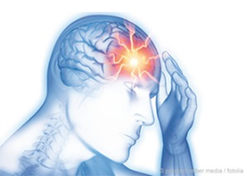Harbinger of a stroke

A mini-stroke, known in medical terminology as a "transient ischemic attack" (TIA), manifests itself differently in every person. The symptoms are the same as in a "major" stroke, only the duration is shorter. Whereas the symptoms of a true stroke persist for more than 24 hours, TIA symptoms usually last only a few minutes. At the Medical Center – University of Freiburg, specialists treat those affected, because it often brings dangerous consequences.
"A mini-stroke, like a major stroke, is triggered by a circulatory problem, but it does not actually cause an ischemic stroke. This means that no brain tissue dies," says Professor Dr. Jürgen Bardutzky, head of the specialized Stroke Unit and Senior Physician in the Department of Neurology and Neurophysiology of the Medical Center – University of Freiburg. However, recent studies using magnetic resonance imaging show that a small cerebral infarction is often detectable after 60 minutes.
Typical symptoms are brief vision problems, signs of paralysis and speech disorders
The symptoms of a "TIA" correspond to the classic symptoms of stroke: sudden vision problems, brief blindness in one eye, passing signs of one-sided paralysis in body parts such as the hands, arms, legs or half the face, speech impediments, slurred speech, dizziness and double vision. Professor Bardutzky warns against underestimating the symptoms: "After such an attack, ten percent of patients experience a true stroke within the next seven days. Therefore – and also because one does not at first even know whether the symptoms will regress on their own – it is enormously important that those affected and involved act immediately and dial the emergency number 112." If the symptoms have disappeared, a "TIA" is present.
Nevertheless, an immediate inpatient evaluation of the causes in the Stroke Unit is absolutely necessary. In the Stroke Unit of the Medical Center – University of Freiburg, specialists observe the disease development of the TIA patient for three to four days. In the process they use ultrasound to examine the blood vessels of the brain and heart, look at the brain using slice imaging, and analyze any cardiac arrhythmias in order to search for "high-risk causes" of a stroke.
Preventing a true stroke through swift clarification
"A TIA leaves behind no permanent damage. Still, it is dangerous, and for neurologists represents a medical emergency," says Professor Bardutzky. A comprehensive, rapid diagnosis of the symptoms and causes can reduce the risk of a subsequent true stroke by about 80 percent, by allowing doctors to provide matched medication or else, for example, operate on a narrowed carotid artery. This is why immediate diagnosis is so important. Sometimes patients confuse the symptoms of a severe migraine or a numb leg with a "TIA" and come to the ward, but "that's better than not acting at all – that's how to avoid something worse," says Professor Bardutzky.
Yet lifestyle habits also play an important role in preventing strokes: smoking, physical inactivity, excess weight and unhealthy diets contribute to dangerous circulatory disorders. These risk factors should be reduced first and foremost. Depending on each case, the neurologists decide which combination of medicines and preventive measures makes the most sense.
Back